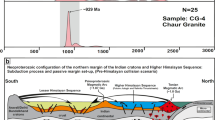Abstract
Um Safi area is located in the southern part of the Central Eastern Desert of Egypt. The total count airborne radiometric survey data of this area have been treated qualitatively and quantitatively and correlated with the geological map of the study area. The total count image of this area shows some radiometric anomalies related to the younger granites and are structurally controlled by the dominating faults trending in NW–SE, NE–SW, and E–W directions. The map also shows some anomalies associated with the rhyolite flow tuffs. This survey indicates that the study area possesses gamma radiation ranging between 0.5 and 14 Ur as a total count. Field investigations reveal that the basement rock units of Um Safi area are extruded by rhyolite stocks and trachyte plugs and these rocks show high potentiality of radiometric elements. Detailed ground geological and geophysical studies are made over the rhyolite zone of Um Safi area by the authors; these surveys of detailed ground survey have been conducted along 16 parallel profiles oriented at N–S direction with profile separation of 40 m and with stations every 20 m along the profiles. The location of each station was determined using GPS. The analysis of the gamma-ray spectrometric readings for the rhyolite zone of Um Safi area by using the Geosoft programs indicates that there is an increase in the eTh content from 18 to 397 ppm eTh at the rhyolitic volcanic rocks. Moreover, the eU content shows an increase from 2 to 95 ppm eU at these rocks. The main trend of their eU and eTh anomalies is the NW–SE direction. The VLF method was used and the data were interpreted qualitatively to determine the location of subsurface structures. The highly conductive zones, that are consistent with rhyolite rocks trending in the NW–SE and NE–SW direction, are due to mineralization and they are interpreted as fractured mineralized zones. The integration of the results of the ground gamma-ray and VLF-EM interpretation reveal that all the radiometric anomalies lie over the rhyolite rocks and are associated with elongated positive conductivity anomalies having NW–SE and NE–SW direction. The NW–SE direction is considered as the main trend which plays an effective role in the distribution of the radioactive elements in the rhyolite zone of Um Safi area.




















Similar content being viewed by others
References
Abdel Meguid, AA, Cuney, M, Ammar, SE, Ibrahim, TMM, Ali, KhG, Shahin, HA, Omer, SA, Gaafar, IM, Masoud, SM, Khamis, AA, Haridy, MH, Kamel, AI, Mostafa, MB, Abu Donia, AMH, Abdel Gawad, A and Aly, EM (2003) Uranium potential of Eastern Desert Granites, Egypt. Internal report, NMA, Cairo, Egypt
Aero-Service (1984) Final operational report of airborne magnetic/radiation survey in the Eastern Desert, Egypt, for the Egyptian General Petroleum Corporation, Cairo, Egypt. Aero-Service Houston, Texas, USA, April, 1984, Six Volumes
Fraser DC (1969) Contouring of VLF-EM data. Geophysics 34:958–967
Grasty, RL, Holman, PB and Blanchard, YB (1991) Transportable calibration pads for ground and airborne gamma-ray spectrometers, Ottawa, Canada. Geological Survey of Canada, Paper 90–23, 24 p
International Atomic Energy Agency (IAEA) (1979) Gamma-ray surveys in uranium exploration, IAEA, Vienna, Austria, Technical Report Series No. 186, 90 p
International Atomic Energy Agency (IAEA) (1991) Airborne gamma-ray spectrometer surveying. IAEA, Vienna, Austria, Technical Report Series No. 323, 97 p
International Atomic Energy Agency (IAEA) (2000) 5th international conference on High level of natural Radiation, Munich, 2000, (“Waste solutions” Vol.42 No3, Vienna, Austria, pp7). Technical Report Series 186, 90 p., Vienna, Austria
ITAM5: Introduction to Australia’s Minerals, UIC-Uranium Information Centre Ltd GPO Box 1649 N, Melbourne 3001, Australia
Karous M, Hjelt SE (1983) Linear-filtering of VLF dip-angle measurements. Geophys Prospect 31:782–894
Ligas P, Palmoba M (2006) An integrated application of geological- geophysical methodologies as a cost-efficient tool in improving estimation of clay deposit potential: case study from South-Central sardine (Italy). Ore Geol Rev 29:162–175
Milson, J, (2002) Field geophysics. Cambridge university press
Pitfield, PEJ, Abdel Gawad, GM, Salem, SM and Makhlouf, AA (1996) The geology of the Hadayib area. 34 p
Ramesh Babu V, Subhash Ram Sundararajan N (2007) Modeling and inversion of magnetic and VLF-EM data with an application to basement fractures: a case study from Raigarh, India. Geophysics 72:133–140
Sarma DD, Koch GS (1980) A statistical analysis of exploration geochemical data for uranium. Math Geol 12(2):99–114
Saydam AS (1981) Very low-frequency electromagnetic interpretation using tilt angle and ellipticity measurements. Geophysics 46:1594–1605
Sharma SP, Baranwal VC (2005) Delineation of groundwater-bearing fracture zones in a hard rock area integrating very low frequency electromagnetic and resistivity data. J Appl Geophys 57:155166
Wenrich, KJ (1985) Geochemical characteristics of uranium-enriched volcanic rocks. IAEA-TC-490/1. p 29–51
Wright JL (1988) VLF interpretation manual. EDA Instrument, Toronto, Ontario, Canada
Author information
Authors and Affiliations
Corresponding author
Rights and permissions
About this article
Cite this article
Abouelnaga, H.S.O., El-Shayeb, H., Mahmoud, T. et al. Ground geophysical survey for studying the potentiality of uranium mineralization in rhyolite zone—Um Safi area, Central Eastern Desert, Egypt. Arab J Geosci 8, 6279–6303 (2015). https://doi.org/10.1007/s12517-014-1612-7
Received:
Accepted:
Published:
Issue Date:
DOI: https://doi.org/10.1007/s12517-014-1612-7




